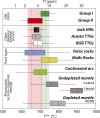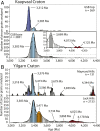Heterogeneous Hadean crust with ambient mantle affinity recorded in detrital zircons of the Green Sandstone Bed, South Africa
- PMID: 33602806
- PMCID: PMC7923375
- DOI: 10.1073/pnas.2004370118
Heterogeneous Hadean crust with ambient mantle affinity recorded in detrital zircons of the Green Sandstone Bed, South Africa
Abstract
The nature of Earth's earliest crust and the processes by which it formed remain major issues in Precambrian geology. Due to the absence of a rock record older than ∼4.02 Ga, the only direct record of the Hadean is from rare detrital zircon and that largely from a single area: the Jack Hills and Mount Narryer region of Western Australia. Here, we report on the geochemistry of Hadean detrital zircons as old as 4.15 Ga from the newly discovered Green Sandstone Bed in the Barberton greenstone belt, South Africa. We demonstrate that the U-Nb-Sc-Yb systematics of the majority of these Hadean zircons show a mantle affinity as seen in zircon from modern plume-type mantle environments and do not resemble zircon from modern continental or oceanic arcs. The zircon trace element compositions furthermore suggest magma compositions ranging from higher temperature, primitive to lower temperature, and more evolved tonalite-trondhjemite-granodiorite (TTG)-like magmas that experienced some reworking of hydrated crust. We propose that the Hadean parental magmas of the Green Sandstone Bed zircons formed from remelting of mafic, mantle-derived crust that experienced some hydrous input during melting but not from the processes seen in modern arc magmatism.
Keywords: Hadean; crustal evolution; early Earth; zircon.
Conflict of interest statement
The authors declare no competing interest.
Figures





Similar articles
-
Zircon geochemistry from early evolved terranes records coeval stagnant- and mobile-lid tectonic regimes.Proc Natl Acad Sci U S A. 2024 Sep 24;121(39):e2405378121. doi: 10.1073/pnas.2405378121. Epub 2024 Sep 16. Proc Natl Acad Sci U S A. 2024. PMID: 39284064 Free PMC article.
-
Hadean diamonds in zircon from Jack Hills, Western Australia.Nature. 2007 Aug 23;448(7156):917-20. doi: 10.1038/nature06083. Nature. 2007. PMID: 17713532
-
An andesitic source for Jack Hills zircon supports onset of plate tectonics in the Hadean.Nat Commun. 2020 Mar 6;11(1):1241. doi: 10.1038/s41467-020-14857-1. Nat Commun. 2020. PMID: 32144246 Free PMC article.
-
When crust comes of age: on the chemical evolution of Archaean, felsic continental crust by crustal drip tectonics.Philos Trans A Math Phys Eng Sci. 2018 Oct 1;376(2132):20180103. doi: 10.1098/rsta.2018.0103. Philos Trans A Math Phys Eng Sci. 2018. PMID: 30275165 Free PMC article. Review.
-
The Hadean-Archaean environment.Cold Spring Harb Perspect Biol. 2010 Jun;2(6):a002527. doi: 10.1101/cshperspect.a002527. Epub 2010 May 5. Cold Spring Harb Perspect Biol. 2010. PMID: 20516134 Free PMC article. Review.
Cited by
-
Zircon geochemistry from early evolved terranes records coeval stagnant- and mobile-lid tectonic regimes.Proc Natl Acad Sci U S A. 2024 Sep 24;121(39):e2405378121. doi: 10.1073/pnas.2405378121. Epub 2024 Sep 16. Proc Natl Acad Sci U S A. 2024. PMID: 39284064 Free PMC article.
-
Sediment subduction in Hadean revealed by machine learning.Proc Natl Acad Sci U S A. 2024 Jul 23;121(30):e2405160121. doi: 10.1073/pnas.2405160121. Epub 2024 Jul 8. Proc Natl Acad Sci U S A. 2024. PMID: 38976765 Free PMC article.
-
Making continental crust on water-bearing terrestrial planets.Sci Adv. 2025 Mar 28;11(13):eads6746. doi: 10.1126/sciadv.ads6746. Epub 2025 Mar 26. Sci Adv. 2025. PMID: 40138399 Free PMC article.
-
Hadaean to Palaeoarchaean stagnant-lid tectonics revealed by zircon magnetism.Nature. 2023 Jun;618(7965):531-536. doi: 10.1038/s41586-023-06024-5. Epub 2023 Jun 14. Nature. 2023. PMID: 37316722 Free PMC article.
-
Using detrital zircon to reconstruct Neoproterozoic crustal thickness variation in the northwestern margin of the Yangtze Block.Sci Rep. 2025 Apr 24;15(1):14240. doi: 10.1038/s41598-025-98883-3. Sci Rep. 2025. PMID: 40275066 Free PMC article.
References
-
- Armstrong R. L., Harmon R. S., Radiogenic isotopes: The case for crustal recycling on a near-steady-state no-continental-growth Earth [and Discussion]. Philos. Trans. R. Soc. A Math. Phys. Eng. Sci. 301, 443–472 (1981).
-
- Harrison T. M., Schmitt A. K., McCulloch M. T., Lovera O. M., Early (≥ 4.5 Ga) formation of terrestrial crust: Lu-Hf, δ18O, and Ti thermometry results for hadean zircons. Earth Planet. Sci. Lett. 268, 476–486 (2008).
-
- Kamber B. S., The Enigma of the Terrestrial Protocrust: Evidence for its Former Existence and the Importance of its Complete Disappearance (Dev. Precambrian Geol, 2007), chap. 2.4.
-
- Bauer A. B., et al. ., Hafnium isotopes in zircons document the gradual onset of mobile-lid tectonics. Geochem. Perspect. Lett. 14, 1–6 (2020).
Publication types
LinkOut - more resources
Full Text Sources
Other Literature Sources

